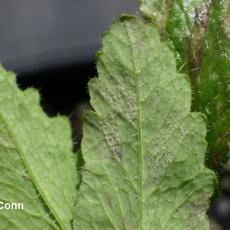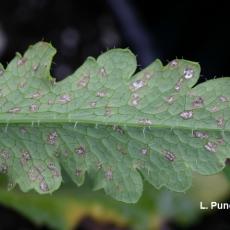Separate examples of Poppy Downy Mildew caused by Peronospora arborescens. Downy mildew caused by species of Peronospora,Bremia, Plasmopara, and Basidiophora has become a serious problem in the ornamental industry. The pathogens are obligate parasites that infect certain species of ornamentals selectively.
Symptoms occur as angular, chlorotic to necrotic spots on the upper leaf surface, distorted growth and eventually a purplish, downy growth on undersides. Monitor greenhouses regularly for symptoms of Downy Mildew. Control depends on fungicide applications, the use of resistant cultivars, and cultural practices. Minimize periods of leaf wetness by reducing density of the plant canopy and avoiding overhead irrigation. High humidity, prolonged leaf wetness, and cool weather favor the development of Downy Mildew diseases. Heat and vent greenhouses in evening and early morning, especially when warm days are followed by cool nights, to reduce relative humidity. Once infection is established, sporangiophores emerge from the stomata on leaf undersides and sporangia are easily spread by splashing water,wind, or handling.
Downy mildew fungi may reside in plant debris or weed hosts. Remove infected plants and weeds. Avoid prolonged periods of leaf wetness. Scout greenhouses regularly for symptoms of Downy Mildew and apply fungicides on a preventive basis in a regular spray program once the disease is detected. Fungicides registered for Downy Mildew include Alliette, Alude, Stature, Subdue Maxx, Heritage, and Compass O. Apply these chemicals in a tank mix with contact fungicides such as chlorothalonil, copper, or sulfur and rotate among chemical classes to prevent fungicide resistance development in the pathogen population.
Fact Sheet (scroll from this list): Downy Mildew Diseases of Ornamental Plants


